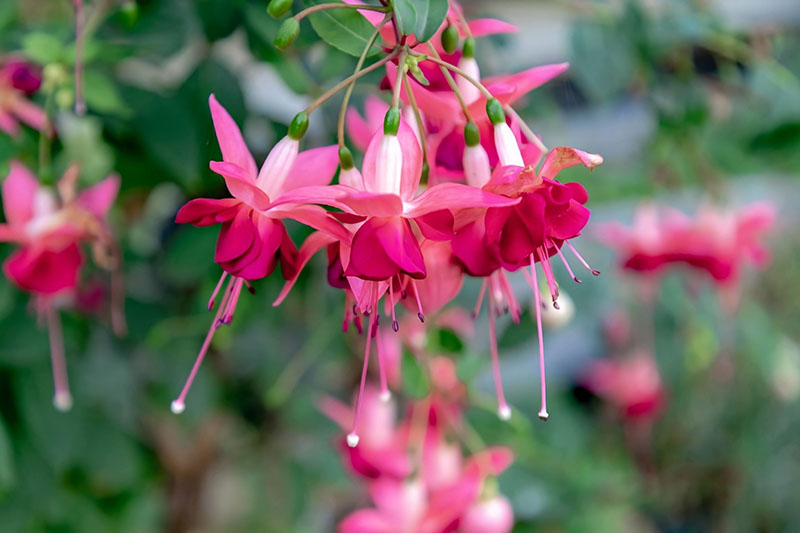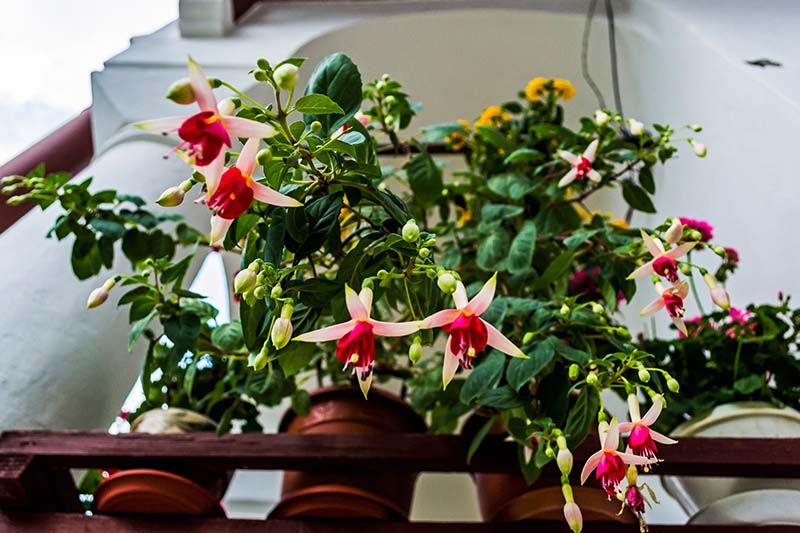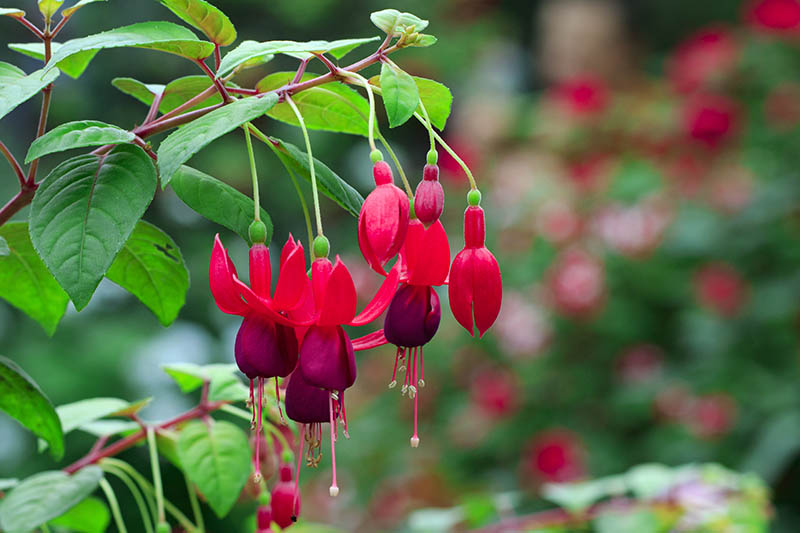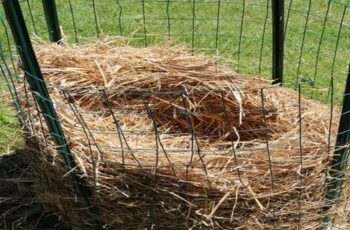Ad Blocker Detected
Our website is made possible by displaying online advertisements to our visitors. Please consider supporting us by disabling your ad blocker.
One of the common misconceptions about fuchsia is that it doesn’t handle the sun well. But that’s not true!

The issue here is keeping the soil moist and cool. While it can happily grow in the shade, it’ll bloom more prolifically if you give it some sun.
The ideal situation is dappled sunlight for 8 hours a day, but in cooler areas, you can provide some direct light for several hours. Full early morning sun is fine.
In-ground hardy fuchsia can thrive in full sun conditions in places like the Pacific Northwest, but they should be limited to half a day of sun in hotter areas where full sun paired with high temperatures can cause more of a strain to plants and dry them out more quickly.

Whether you are growing in the shade or in the sun, the roots can’t tolerate conditions that are too hot or dry. I believe that’s why fuchsia has a reputation for being difficult to grow. Too much heat and the poor thing just can’t handle it.
Keep the soil consistently moist, but don’t allow the roots to remain in standing water. This plant needs well-draining soil and doesn’t like wet feet.
The earth should feel like a well-wrung-out sponge. One easy way to tell if it’s time to water if you have a hanging plant is to lift it. Feel light? Add water.
Don’t let the roots get overheated. Constant moisture will help with this, and a two to three-inch layer of mulch will, too. If you’re growing in a container, keep it in a place where the afternoon sun won’t hit the container directly.

In general, fuchsia prefers temperatures somewhere in the 70s, and about 10 degrees cooler at night, so keep an eye on things when the summer heats up. That’s when many people lose their plants, another reason, I think, that fuchsia has a reputation for being fussy.
To deal with this problem, you can grow it in a container placed in the part sun during the spring and fall, and move it into a shadier spot in the summer. You can even bury the container during the hottest part of the year if it really gets toasty in your area.
Keep a close eye on container-grown plants, as pots tend to dry out much quicker than soil in the garden.
On warm days, your plant may start to wilt. This can happen because the plant has closed its stomata to preserve water.
Before you jump in with the watering hose to perk it back up, check the soil. If it feels moist to the touch, don’t add water. If you can move it, take it to a cooler, shaded area and mist it with water to help cool it down.
If the soil is dry, give it a good soak of water. After an hour or so, you can also give it a spritz with a water bottle or use the mist setting on a hose nozzle.
Fertilizing
Choose a fertilizer that is higher in phosphorus to promote root and flower growth. Miracle-Gro Bloom Booster 15-30-15 (NPK), available HERE , is a good option.
Fertilize every two weeks when the plant is in bloom.
If your plant isn’t blooming, feed it with a balanced 18-18-18 fertilizer. Don’t ever apply fertilizer when the soil is dry or if the plant is wilted.
Hardy fuchsias growing in the ground can be fertilized every two to four weeks with 18-18-18 (NPK) during the growing season.
Slow fertilizing to once a month starting in October, and stop entirely when plants are dormant over the winter months. You can start fertilizing again when your plant shows signs of new growth in the spring.
Growing Indoors
Some people toss fuchsia at the end of the summer after it has finished blooming.
You can also take your plants indoors to overwinter them in pots and they’ll return in the spring better than ever.
Growing Tips
Fuchsia has some specific needs, but once you know what they are, you can keep this plant happy without too much effort.
- Keep the soil moist but not wet. The top half inch shouldn’t be allowed to dry out completely between watering.
- Plants can handle full sun so long as they don’t get too hot. Put them in part sun or part to full shade if temps climb above 70°F.
- This plant has high nutritional requirements. Feed it regularly.
Pruning and Maintenance
You need to deadhead these plants to encourage continual blooming. Otherwise, the pollinated flowers turn into fruits.
You can eat the fruit, but allowing them to develop will also mean the end of blossom time.
If you keep up with deadheading, your plant can continue to bloom even through the winter if you live in an area that stays warm enough, with daytime temps between 60-70°F, or if you keep the plant indoors.
You might need to move it into full sunlight to encourage flowering, however, if it isn’t growing in a full sun location already.
Most species start blooming in June, and fuchsias develop blossoms on new growth.
What does this mean for you? Plan to prune the plant back to keep its shape in the early spring when new growth just starts to emerge, but before flower buds have formed. Resist the temptation to prune in the fall, as this can leave plants vulnerable to frost damage.
Remove any dead or crossing branches and any branches that look weak or spindly. You can also prune the entire plant back by a third if desired.
Prune the branches of potted plants back by one-third, but be sure to leave at least two leaf nodes in place on each.
Pruning time is ideal for repotting, as well. If your plant has become root bound, pull it from its current container, gently loosen the roots, and remove any that are dead before replanting.
Smaller plants grown in the ground or in containers can be divided if desired, every few years as described above, though this is not necessary.
Again, remember that it is important to take care to dig up as much of the root system as possible for any plant growing in the ground. These beauties have deep root systems, and larger plants do not respond well to transplanting.
Mulch with two inches of well-rotted compost, straw, or grass clippings to keep the moisture in place in the soil, keep the roots cool, and protect the plant from winter chills.

